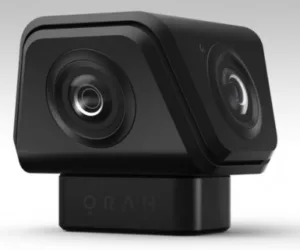Even a quick on-line search will reveal that there are a variety of spherical capture cameras currently available for sale. Although there is no shortage of hardware, the issue of how the video captured by such cameras can be shared is not well developed. VideoStitch (Paris, France with an office in San Francisco, CA) is attempting to address this issue with a product called the Orah 4i. The Orah 4i camera and software system is capable of streaming 4K resolution live “virtual reality video” to HMDs.
The central feature of the approach adopted by VideoStitch to share VR video is to instantly upload captured video to the web. Users have immediately access to the video and can pan through the video on their 2D computer screen or view the video on their HMD. In addition, and if desired, the video can be recorded on a SD card.
In looking at the Orah 4i system, first consider the hardware.
The Orah 4i is composed of four cameras mounted in an aluminum body. Each camera contains a f/2.0 fish eye lens. The overlapping fields of view of the four cameras allows video capture over an entire 360o X 180o spherical field of view. The sensor in each camera has a video resolution of 2048 X 1536 pixels and is capable of recording 4K video at 30 FPS. Each camera has built-in image stabilization and horizon correction as well as a dynamic range microphone.
There is a real technical challenge in properly assembling the 4K videos produced by the four cameras into a single, high resolution, seamless panoramic VR video. The term properly assembling in this case includes stitching together the four images and removing the image distortion that comes with the use of fish eye lenses – and to do so in real time!
To get this done, the company offers VideoStitch Studio. This is a post-production video stitching software that enables users to create immersive spherical VR videos.
VideoStitch utilizes a proprietary computing unit that fits into the base of the tripod typically used to mount the Orah 4i. The base includes an Intel CPU and Nvidia GeForce CPU to make the stitching as fast as possible. The maximum post produced output resolution of the live processing unit is 4800 X 2400 pixels. The resulting video typically covers a 360o X 180o spherical field of view in a “world map” style of geometric projection and does so at 4K resolution. Other geometric projections and resolutions can be targeted, such as the “little planet” effect or circular fisheye for immersive dome theaters. VideoStitch includes features including: input synchronization, exposure and white balance. Spherical video is delivered as a regular video file or stream. The interactive video player then remaps the file or stream to show only the field of view looked at by the user.
The physical size of the so-called Stitching Box is 10.8 X 5.1 X 10.4 inches (27cm x 13cm x 26.4cm) with a weight of 6 pounds (2.7Kg)
VideoStitch’s software suite is compatible with a variety of multi camera assemblies, some of which are quite complex. “Until today, a live VR video production workflow relied on an array of small cameras put together on a holder. Videographers then dealt with multiple cables, power supplies and a variety of small hardware components.” Although the VideoStitch product is suitable for these more sophisticated applications, the company stated that the target market of the Orah 4i product is the less professional, more consumer oriented market. VideoStitch believes that this segment of the market is not well served with current product offerings. The company claims that the Orah 4i overcomes the deficiencies found in these other product offerings thus letting users focus on creating content.
An entertaining but not overly informative video describing the Orah 4i can be found following this article.
The Orah 4i system “works out of the box in most modern desktop web browser, and using the ubiquitous Adobe Flash player on older browser. Recent smartphones all support HD 360 video playback in native applications. While ‘augmented’ video content and head mounted devices such as the popular Oculus provide an astonishing immersive experience.”
The Orah 4i is currently being offered to early adopters at a substantial discount. Customers that pre-order the Orah 4i during April will pay a price of $1,795. After April 30, the price of the device will be increased incrementally to the final purchase price of $3,595. -Arthur Berman

